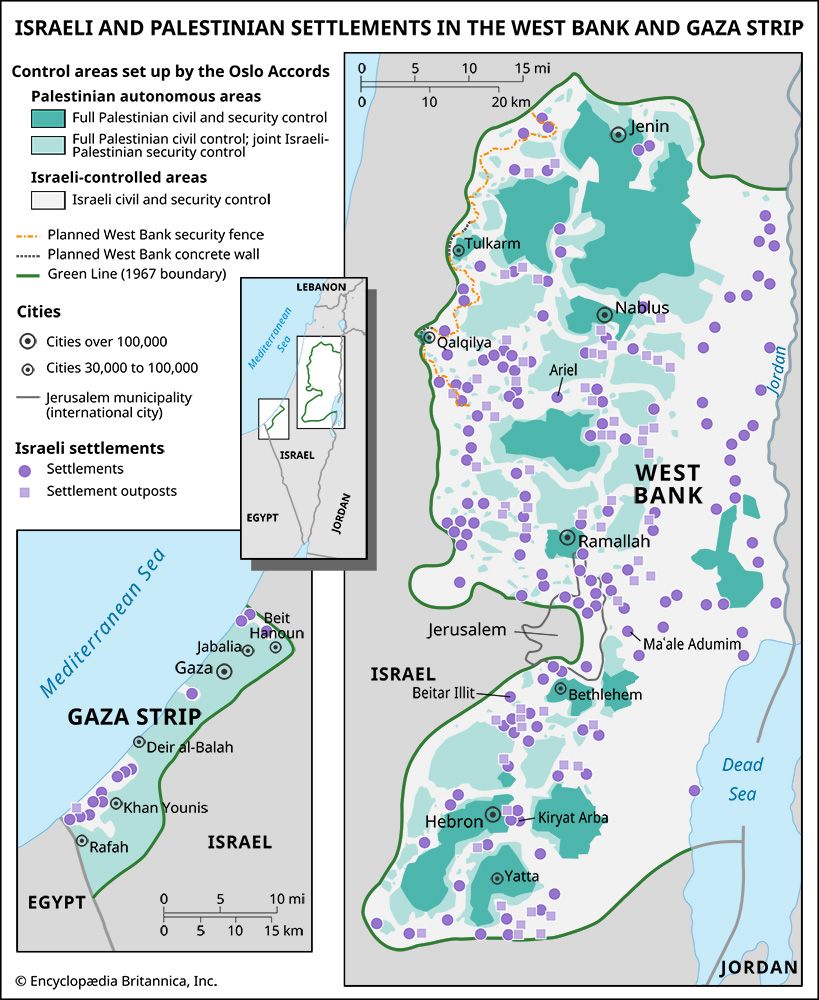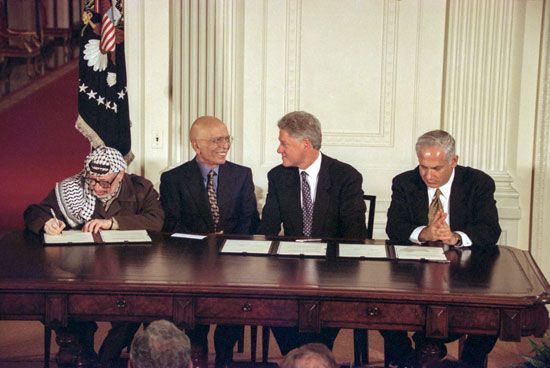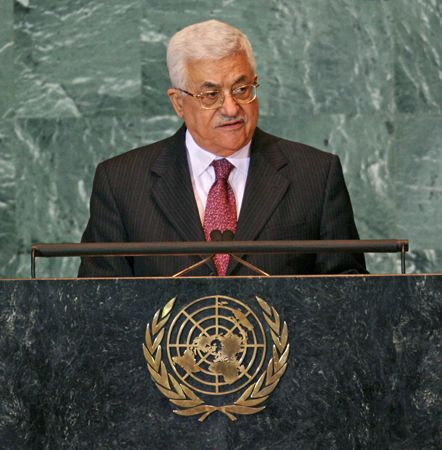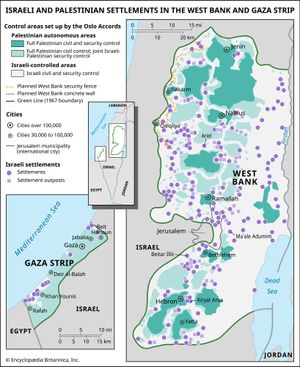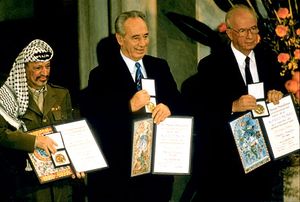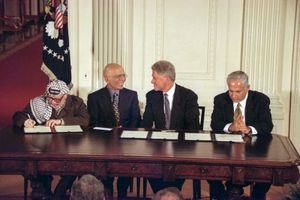Palestinian Authority
- Formally:
- Palestinian National Authority or
- Arabic:
- al-Sulṭah al-Waṭaniyyah al-Filasṭīniyyah
- Self-declared:
- State of Palestine or
- Arabic:
- Dawlat Filasṭīn
- Date:
- 1994 - present
News •
Palestinian Authority (PA), governing body of the Palestinian autonomous regions in the West Bank. Established in 1994 as part of the Oslo Accords peace agreement between Israel and the Palestine Liberation Organization (PLO), the PA also has de jure governing authority over the entirety of the Gaza Strip, but it has not exercised de facto control there since 2007, when Hamas took control of the region by force. Although the PA was, until then, democratic, Pres. Mahmoud Abbas has since ruled by decree and indefinitely delayed elections. By 2011 the PA had built up institutions for a functioning state, but it later suffered repeated financial crises under pressure from Israel and others.
The PA was founded following years of hostility. Secret meetings held in Norway in 1993 between the PLO and Israel led to the signing of the historic Declaration of Principles (the Oslo Accords), in which the two sides agreed to mutual recognition and terms whereby governing functions in the West Bank and the Gaza Strip—occupied by Israel since the Six-Day War of 1967—would be progressively handed over to a Palestinian council. During that time—in what generally came to be known as the Oslo process—Israel and the Palestinians were to negotiate a permanent peace treaty to settle on the final status of these territories. The agreements between the sides called for the Palestinian Authority (PA) to take control over most populated areas in the occupied territories. Security for those areas would rest with the Palestinian police, although Israelis would be guaranteed freedom of movement. Several militant Islamic groups, particularly Hamas, denounced the peace agreement.
Administration
The PA is governed by an interim constitution known as the Basic Law, which may be amended by the legislature by a two-thirds majority. The president is elected directly to a four-year term, with a limit of two terms. The president is the commander in chief of the security forces, manages foreign relations, has the power to veto legislation, and may issue decrees when the legislature is not in session. The prime minister, appointed by the president, and the council of ministers hold primary executive authority, subject to the confidence of the Palestinian Legislative Council (PLC). The PLC consists of 132 members elected to four-year terms. According to the 2005 amendment to the Basic Law, the 2006 election was a mixed majority and proportional representation system. This resulted in the controversial outcome of Hamas winning 74 seats although it received 44 percent of the vote (against Fatah’s 41 percent). In 2007 the Basic Law was amended to make the system fully proportional. A number of seats, defined by presidential decree, are allocated to Christians, and political parties must include a certain number of women on their lists, including one in the top three slots. Amid Fatah-Hamas factional violence in 2007, Pres. Mahmoud Abbas dismissed the government and declared a state of emergency, and thereafter he ruled by decree.
Regional governance is divided into 16 governorates—11 in the West Bank and 5 in the Gaza Strip. Per the 1995 Interim Agreement on the West Bank and the Gaza Strip with Israel (also known as Oslo II), these territories are divided into three types of administration: areas under PA administration and security (Area A), areas under PA administration but joint Israeli-Palestinian security (Area B), and areas under Israeli administration and security (Area C). As a key proviso of the Oslo Accords, PA security forces operate in partnership with the Israel Defense Forces (IDF), which has included training, cooperation, joint patrols, and intelligence sharing; security makes up one-third of the expenditure of the PA.
History
Presidency of Yasser Arafat
The PA first assumed some civil functions in 1994, when the Israeli military withdrew from the cities of Gaza and Jericho. Six other cities followed in 1995, and elections were held in 1996.
The first Israeli withdrawals took place in 1994, from the cities of Gaza and Jericho. That same year the PA assumed control of many civil functions, and its autonomous authority was extended to six other cities in 1995. On January 20, 1996, elections were held in PA-administered areas for the presidency and the PLC. PLO chairman Yasser Arafat was easily elected president, and his Fatah party gained a majority of seats within the PLC.
Arafat’s presidency was tasked with building the institutions and rapport of the fledgling PA while, per the terms of the Oslo Accords, stemming violence against Israel carried out by Palestinians. Because some Palestinians, especially Fatah’s rival organization Hamas, were unhappy with concessions Arafat had made to Israel in the Oslo Accords, violence increased in 1996. The continued violence convinced many that Arafat was either unable or unwilling to curb violence, and it contributed to doubts among many that the two-state solution could actually bring about peace. Benjamin Netanyahu, who campaigned on the slogan “Peace with security,” was granted a surprise victory in Israel’s 1996 parliamentary elections. Aspects of Israel’s implementation of the Oslo Accords were delayed or halted under Prime Minister Netanyahu, resulting in the negotiation in 1998 of the Wye River Memorandum, which made Israeli withdrawal from the West Bank and the Gaza Strip contingent on the PA’s actions to crack down on violence. Domestic politics in Israel caused the memorandum to be suspended in 1999.
Ongoing violence in the 1990s raised doubts in Israel that the Oslo process would bring peace. The process began to stall, intifada broke out, and the international community began to push for new leadership in the PA.
Amid a growing sense of distrust and pessimism between Israelis and Palestinians, U.S. Pres. Bill Clinton convened a two-week summit at Camp David in July 2000 to hash out final status issues, including the division of Jerusalem. No agreement was reached. Attempting to capitalize on many Israelis’ dissatisfaction with Prime Minister Ehud Barak’s willingness to divide Jerusalem, Ariel Sharon—the leader of the opposition in the Knesset and a former defense minister infamous for his role in the 1982 massacre at a Palestinian refugee camp—made a provocative visit to the Temple Mount, where Islam’s third holiest site sits (see Dome of the Rock). Palestinians were outraged, resulting in angry demonstrations and the beginning of the second intifada. By the end of 2001, as the intifada and Israel’s response to it had escalated, the IDF had confined Arafat to his Ramallah compound. He remained there until the final days of his life in 2004.
In 2003, amid intense international pressure for new Palestinian leadership, the post of prime minister was established, and Abbas became the first person to occupy the office. However, he resigned only months later, claiming that his role in the post had been undermined by Israel, the United States, and Arafat. Ahmed Qurei, another chief Oslo negotiator, was named prime minister in his place.



